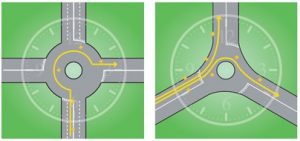Roundabouts
Roundabouts
Not every roundabout is the same. They are different shapes and sizes and can have different numbers of exits. Some are controlled by traffic lights.
The purpose of having a roundabout is:
- to reduce delays – traffic flows smoothly compared to the stop and go traffic at normal intersections such as at traffic lights.
- to significantly reduce the risk of collisions.
- to reduce pollution – emissions from vehicles on roundabouts are less than they would be at traffic light junctions.
Golden Rule
This ‘golden rule’ should help motorists to drive safely at any roundabout regardless of the number of exits:
Think of the roundabout as a clock.
- If taking any exit from the 6 o’clock to the 12 o’clock position, motorists should generally approach in the left-hand lane.
- If taking any exit between the 12 o’clock to the 6 o’clock positions, motorists should generally approach in the right-hand lane.
- If there are road markings showing you what lane you should be in, follow those directions. Traffic conditions might sometimes mean you have to take a different approach but, in the main, the ‘golden rule’ will help you to drive safely on almost any roundabout.
Approaching a roundabout
- Conditions at roundabouts may vary. When you are coming up to a roundabout, look for directional arrows, road markings or signs which might be indicating which lane you should use for the exit you’re taking.
- Move into the correct lane in good time. Use the 12 o’clock ‘golden rule’ to help you plan a safe course of action unless road signs indicate otherwise
- Treat the roundabout as a junction. You must yield to traffic coming from the right, but keep moving if the way is clear.
Making a left turn
Approach in the left-hand lane, indicate ‘left’ as you approach and continue until you have taken the left exit.

Going straight ahead (or any exit to the left of 12 o’clock)
Approach in the left-hand lane (unless road markings say otherwise) but do not indicate ‘left’ until you have passed the exit before the one you intend to take. Where traffic conditions dictate otherwise, for example a long line of traffic in the left lane signalling left or road works in the left lane, you may follow the course shown by the red line.
When leaving the roundabout take extra care at all exits, checking for other road users – for example, cyclists and motorcyclists who may be continuing on the roundabout.
Taking any later exits (those past 12 o’clock – right)
Approach in the right-hand lane (unless road markings say otherwise), indicate ‘right’ on your approach and leave your indicator on until you have passed the exit before the one you intend to take. Then change to the ‘left’ turn indicator. Move over towards the left on the roundabout and continue signalling left to leave.

In all cases watch out for and give plenty of room to:
- pedestrians who may be crossing the approach and exit roads,
- traffic crossing in front of you on the roundabout, especially vehicles intending to leave by the next exit,
- traffic that may be straddling lanes or positioned incorrectly,
- motorcyclists,
- cyclists and horse riders who may stay in the left-hand lane and signal right if they intend to continue round the roundabout,
- long vehicles (including those towing trailers), which might have to take a different course approaching or on the roundabout because of their length. Watch out for their signals.
REMEMBER
Conditions at roundabouts may vary. Exercise caution at all times. In particular, be aware of traffic signs, traffic lights, road markings and traffic coming from your right when approaching roundabouts.
Acknowledgement Road Safety Authority